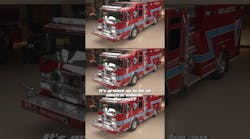When I sat down at the computer to begin work on this little session with you, I was torn in a number of directions. Should I write about something interpersonal, something technical, or something from my career in the fire service? I had trouble making the decision. My mind tossed and turned as I battled the demons of writer's doubt. Then it came to me in a flash! If I was having trouble making a decision, then maybe it was time to write about decision-making.
However, since I wasn’t sure, I pondered for a while; then I rethought the concept. When it seemed right, I decided to start writing. Then I stopped for awhile. Hence my choice of the title for this visit with you. Actually my wife suggested that I am not the one to discuss the concept of decision-making. Jackie says this because it took me six tries before I decided to add onto our home back in the 1980’s when the twins came into our lives. She laughs like crazy every time I share an email from one of you who actually has the audacity to suggest that I have common sense.
The decision tree for the house assessment went something like this. Move; don’t move. Add on; don’t add on. Don’t move; do add on. And so it went for a number of months, during which time, the twins continually grew bigger and bigger. To make a pathetically long story somewhat shorter, we stayed and we added on. Let me tell you that I was one mentally exhausted fire guy by the time that the process was completed. It was truly a learning experience.
Just when I started to get comfortable with my choice the town announced that they were considering the widening of the road where our house is located. The side line for the road project came ten feet into our home or just about dead center to the Lazy-Boy chair where I live, breath and think. You can imagine how poor this made my decision look. Fortunately, they did not widen the road and I am writing to you from that very home today.
Now for the critical part of this article; How does one go about making decisions?
To begin with, a decision is a conscious choice that is made in response to a given situation. In Management in the Fire Service, Carter and Rausch stress that, “...it is necessary to recognize that a decision is rarely a single act. Usually it is a process because making a single decision is not the important thing.” Rare is the time when a situation occurs in a vacuum.
It has been my experience that it is more important that one’s decision making skills manifest themselves in the construction of a series of successful decisions, where one small decision is linked to the next. These decisions chains can form the basis for success in any aspect of fire service operations.
These chains fall into one of three distinct groups:
· Problem-Solving Chains
· Opportunity-Exploiting Chains
· Project-Management Chains
In the case of the problem solving chain you are forced to face situations which are not what you expect. Carter and Rausch state that these, “... frequently emerge when a difference is observed between ‘what is’ and ‘what should be’. A problem exists and it must be addressed.” Quite simply, something is wrong, and a decision is needed to make it right.
The need for decisions under the opportunity-exploiting chain normally do not have the same level of urgency found with the Problem-Solving Chain. In this case the decision is driven by the “difference of ‘what is’ and ‘what could be’.” In just about every fire department, the potential exists for improvements. A good decision involves the maximization of benefit for the agency. In order to be effective, the decision must be based on a reflective review of the organization, as it actually exists.
Decision made under the project-management chain cover the day-to-day operations of the fire department, as well as any special projects which may be on-going. These decisions may be routine in nature, such as the management of a budget, or determining which inspections will be conducted next week. They might also bear on the development of special projects such as new stations, new programs, or a long-range apparatus replacement plan.
It is critical for me to stress at this point that the primary thing which must be stressed to you is that you must recognize that a problem exists. If you do not see a problem, you cannot solve a problem. Unfortunately, people sometimes tend to react to problems with an air of denial. Some of the ways in which people deal (or do not deal) with problems are:
· Deny that a problem exists
· Camouflage the problems
· Blame someone else
Far too many of you live to use the last one. You blame and blame until it just doesn’t work any more. Then when you finally come to the realization that a problem exists, you will discover that the need exists to have a plan for making the necessary decisions in your life. Based upon many years of research, experimentation, and the actual living of life, I have decided upon a basic seven-step plan for making decisions within our personal and professional lives:
· Recognize that a problem exists
· Analyze the data surrounding the situation
· Develop alternative solutions which seem to fit the situation
· Evaluate the alternatives to see which one will probably fit your needs best
· Choice one
· Do it
· Evaluate the feedback and make adjustments as necessary
And if the solution does not work, select another. If none of your solutions works then it may well be necessary to go back to step one. Redefine the problem and reanalyze the data. Work the system until you get it right. That will equal a solved problem.
While it may be difficult to remember all of the steps, we would urge you to commit them to memory. We would also strongly advise that you use them in order. Do not jump steps or jump to obvious conclusions. This can lead to problems, and problems are what you are attempting to solve with your decision-making process.
Let me strongly suggest that if you aspire to become a fire chief, you had best make your mind up to do one thing: learn how to make a decision! Decisions are the things that fire chiefs get paid to do: whether that salary comes in dollars or personal satisfaction. And you certainly cannot make a decision if you are too tied up in the mechanisms of making that decision. You've got to make decisions, not study things to death. In other words, get off the dime and do some decisions.
One of the primary criteria for judging an effective chief is that person's ability to make decisions on at daily basis, in a timely fashion and only when that decision must be made by the chief. That's right, not every decision has to be made by the chief. It is the mark of a good chief that he or she lets others make decisions at the lowest appropriate level possible.
That's what this article is all about. It is our goal to provide you with a good decision-making system, pat you on the head and send you out into the cold cruel world to earn your way in that old fashioned way; one hard decision at a time.
As we stated earlier, a decision is the conscious choice of an action in response to a problem, based upon a given set of circumstances. So what are we saying? To make a decision requires making a choice with a real-world scenario. There are two basic types of decisions:
A. Programmed
B. Non-programmed
A programmed decision is one which you expect to make on a regular basis. These are the routine decisions that are the bread and butter of your operation. You will have to repeatedly respond to box alarms, order fuel oil for the fire station and deliver replacement equipment. These are the types of decisions which should be covered by standard operating procedures (SOP's). This frees up your mind for the non programmed, or exceptional decisions which will require the whole of your decision-making time and talents.
Remember, decisions are a means to an end and not an end in and unto themselves. Some people get so caught up in the glory of the mechanics of decision-making that they never get around to actually making the decision. Let me offer a though to you.
THE BEST SOLUTIONS COME TO PEOPLE WHO HAVE TAKEN THE TIME TO BECOME FAMILIAR WITH THE GOALS AND OBJECTIVES OF THEIR ORGANIZATION. This is to say that you must know the parameters of your organizational playing field. Since decisions do not come in a vacuum, you must know what your department is all about and the goals for which it is supposed to strive. You can then create solutions which are logical and acceptable within your organization.
In data analysis, you should take your clues from two places. Let me suggest that you first look at the world around. See what is going on and compare what you do with what the world suggests is proper. You must also review the hard data of the organization you work for. Or you may choose to do both. In any event, you need to know the environment wherein your decisions will be made.
You must make a conscious decision to do something. To avoid this step is to court disaster, because a decision is probably not necessary if no data exists which indicates that one has to be made. Once you have laid out the data which tells you that you must make a decision, go to work developing alternative solutions to the problem which YOU have identified.
Evaluation of solutions is the next critical step on the road to effective decision-making. Do not leap toward the first solution that comes to mind. The most obvious choice may not be the most effective or efficient means to reach the ends you desire.
Incidentally, you should decide what constitutes a good decision before you commence your search for that decision. It makes little sense to entertain alternatives that are too costly, possibly illegal or patently inappropriate for the talent of your personnel. Lay out a range of solutions and then compare them to your specifications.
Pick the one that comes closest to accomplishing what you want done. Do not stretch things out. Some of the worst decisions that I have ever made were ones that I spent to much time agonizing over. Be business-like. Look at the problem, and after an appropriate period of study, solve the problem and move on to the next problem.
Remember to evaluate the feedback generated by any decision you make. While this is more important with non- programmed decisions, it is also good to look at your routine decisions periodically to see if your programmed solution is still appropriate.
Let me warn you that several factors are working to stymie your decision-making procedures. Decisions cannot be divorced from the people making those decisions. Be aware that these people will be making value judgments. These will be based upon their personal background and experience. You must look at who these people are, how they think and what they think about. Their personal biases can tinge their judgment and submarine your operation. Know this fact and exercise caution.
People are all different. They think differently and this may work for you or against you. Be aware of it. The use of a mission statement along with solid goals and objectives can get everyone in your department thinking along the same lines. The mechanics of what constitutes an acceptable level of risk varies from person to person. The amount of risk that a person is willing to tolerate says a lot about the types of decisions that will be made. This can lead to solid decision-making or shooting from the hip. Guard against the latter.
Remember, different people will tolerate the same risk in different ways. And the same person may react differently on consecutive days, given differing personal pressures. If I am giving you the idea that decision-making is difficult, than you have been paying attention.
Lastly, avoid post-decision blues. "Did I make the right decision?" This is a question that has gotten me into trouble on more than one occasion. Once you make a decision, move on, unless the feedback says to take another look. To continually mull things over is to court an ulcer.
When all is said and done, people will only remember your very best and your very worst decisions. And you will not know which is which while you are in the midst of making them. So get on with it, get off the dime and start making some good decisions.






